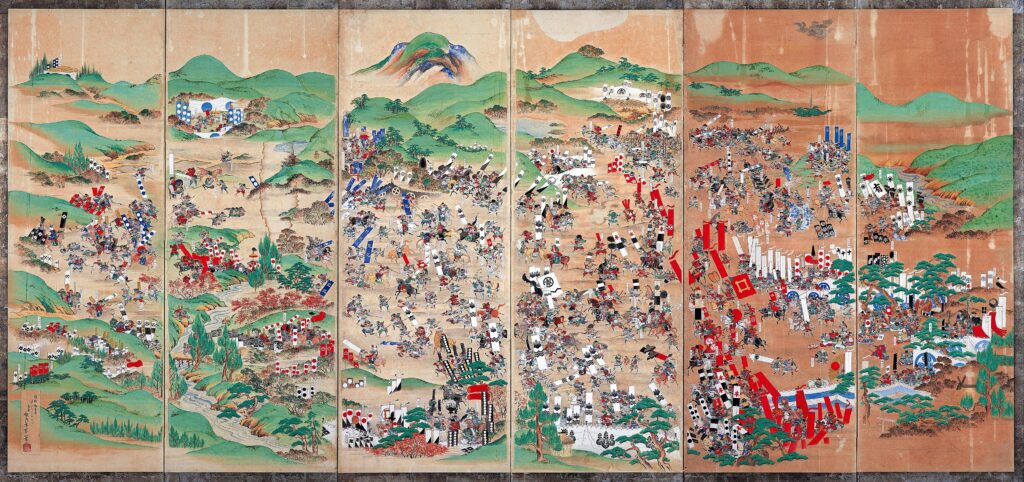If you’re into epic battles, secret alliances and feudal drama, then let’s dive into one of Japan’s biggest historical showdowns: the Battle of Sekigahara! This was the battle that marked the end of an era, setting the stage for the peaceful Edo period under the Tokugawa shogunate. But first, let’s rewind a bit and see what led to this clash of samurai titans in 1600.

By User LordAmeth on en.wikipediaCollection of The Town of Sekigahara Archive of History and Cultural Anthropology – http://www.sengoku-expo.net/flash/sekigahara/byoubu/byoubu_c.htmlhttp://inpaku02.iamas.ac.jp/sekigahara/byoubu/images/l/263.jpg, Public Domain, Link
Background: A Power Vacuum and Tensions Rising
The 1500s in Japan were a chaotic time with constant battles between rival lords (daimyos) as everyone vied for power and land. Then came Oda Nobunaga, a daimyo who nearly unified Japan, followed by his successor Toyotomi Hideyoshi. But after Hideyoshi’s death, Japan was left with a delicate balance of power and an uneasy peace. Hideyoshi’s young son, Toyotomi Hideyori, was too young to rule, and a council of powerful daimyos (basically a “Regency Council”) was set up to rule until he came of age.
One of these council members, Tokugawa Ieyasu, was an ambitious and strategic daimyo. While technically supposed to support the Toyotomi clan, he had his sights set on becoming the top dog in Japan. Cue the tension.
The Road to Sekigahara
With power in limbo, the political scene turned into an intense tug-of-war. Tokugawa Ieyasu had been gathering alliances and strengthening his position. But he wasn’t the only one with plans. Ishida Mitsunari, another powerful daimyo, rallied an opposing coalition to keep the Toyotomi clan in power and prevent Ieyasu from taking over. The stage was set for a huge conflict, as both sides scrambled to gather armies and allies.
By October 1600, these rival forces were ready for the ultimate showdown. On one side, Tokugawa Ieyasu and his Eastern Army, on the other, Ishida Mitsunari and the Western Army.
The Battle: A Foggy Morning and a Midday Twist
On the foggy morning of October 21, 1600, the two armies clashed in the fields of Sekigahara, a strategic mountain pass. As samurai in traditional armor and colorful banners adorned the battlefield, the battle raged on with no clear winner at first. But just when things were heating up, a key betrayal turned the tide.
Kobayakawa Hideaki, a daimyo who was technically on the Western Army’s side, had been secretly wavering. As Ieyasu advanced, Hideaki ultimately betrayed Ishida and switched to the Tokugawa side mid-battle, bringing his troops with him. This sudden twist sent the Western Army into chaos. By the end of the day, the Western forces were crushed, and Ieyasu emerged victorious.
The Aftermath: Ieyasu’s Rise to Power
With his win at Sekigahara, Tokugawa Ieyasu secured his path to power. He soon established the Tokugawa shogunate, a military government that would rule Japan for over 250 years. This era, known as the Edo period, was marked by peace, isolation, and prosperity, with Ieyasu’s descendants ruling until the Meiji Restoration in 1868.
Sekigahara wasn’t just any battle—it was the turning point that led to Japan’s transformation from a war-torn land to a unified, stable nation. It’s no wonder Sekigahara is often called “the battle that shaped Japan.”
Why It’s So Legendary
The Battle of Sekigahara is a prime example of how alliances, strategy, and even betrayal can influence history in huge ways. Plus, with nearly 160,000 samurai involved, it’s hard not to be captivated by the sheer scale of the event. Even today, Sekigahara is commemorated with reenactments, and visitors can explore the historical battlefield where it all went down.
So next time you’re in Japan, you might just want to swing by Sekigahara and walk through the fields where samurai clashed and history was made.
Leave a Reply